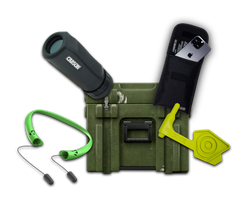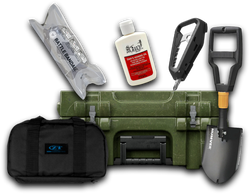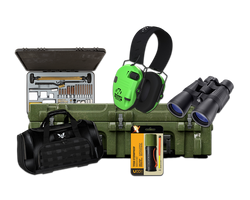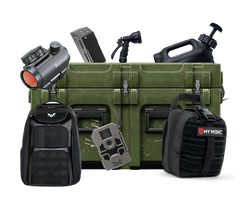How to Use a Flashlight for Self Defense: Enhancing Your Safety with Tactical Gear
Table of Contents
- Introduction
- Why Choose a Tactical Flashlight for Self Defense?
- Understanding Tactical Flashlights
- Techniques for Using a Flashlight in Self Defense
- Conclusion
- FAQ
Introduction
Imagine walking alone in a dimly lit parking lot, the shadows twisting and turning as you make your way to your car. Suddenly, you hear footsteps behind you, and your heart races. In situations like this, having a reliable tool for self-defense could mean the difference between safety and danger. Enter the tactical flashlight—an everyday item that can transform into an essential self-defense weapon.
Modern tactical flashlights are not just for illuminating dark corners. With advancements in technology, these tools have become significantly brighter and more durable. They can serve multiple functions, from illuminating your path to blinding an assailant and even acting as an improvised weapon. In a world where personal safety is paramount, understanding how to effectively use a flashlight for self-defense is crucial.
By the end of this blog post, you'll gain insights into the tactical advantages of using a flashlight, the specific techniques for self-defense, and how to choose the right flashlight for your needs. We’ll also explore how Crate Club’s curated tactical gear, including high-quality flashlights, can enhance your preparedness and confidence in any situation.
Why Choose a Tactical Flashlight for Self Defense?
Versatility and Accessibility
Tactical flashlights are compact and easy to carry, making them a practical addition to your everyday carry (EDC) gear. Unlike traditional flashlights, tactical models are designed for durability and performance, offering features that enhance their effectiveness in self-defense scenarios.
Brightness and Disorientation
One of the significant advantages of a tactical flashlight is its brightness. Many tactical flashlights emit between 200 and 1000 lumens, which can temporarily blind an attacker and provide you crucial seconds to escape. This temporary blindness can disorient an assailant, making them less capable of following through on an attack.
Dual Purpose Functionality
Tactical flashlights are not just light sources; they are designed with additional features that make them effective self-defense tools. Many have serrated edges or a crenulated bezel that can be used to strike an attacker. This dual-purpose functionality makes a tactical flashlight a valuable asset in a self-defense situation.
Readiness and Preparedness
Carrying a tactical flashlight promotes a mindset of readiness. Whether you're navigating through dark areas or facing potential threats, having a flashlight on hand can enhance your confidence and situational awareness. This preparedness is essential in empowering you to take control of your safety.
Understanding Tactical Flashlights
What Makes a Flashlight Tactical?
Tactical flashlights differ from standard flashlights in several ways:
- Construction: Tactical flashlights are typically made from aircraft-grade aluminum, providing durability and resistance to damage.
- Brightness: They usually emit at least 200 lumens, with some models offering much higher outputs, allowing for effective illumination in dark environments.
- Functionality: Many tactical flashlights come with features like strobe modes, which can disorient attackers, and various grip options for easy handling.
- Portability: Their compact size makes them suitable for carrying in a pocket, purse, or attached to a belt.
Key Features to Look For
When selecting a tactical flashlight for self-defense, consider the following features:
- Brightness: Aim for a flashlight with at least 200 lumens for effective self-defense.
- Durability: Look for waterproof and shock-resistant designs.
- Weight and Size: Choose a flashlight that is lightweight and portable, ideally fitting comfortably in your hand.
- Strobe Functionality: A strobe mode can temporarily disorient an assailant, giving you precious seconds to escape.
- Serrated Bezel: This feature can be useful for striking an attacker if necessary.
Crate Club offers a range of tactical flashlights that meet these criteria. You can explore their collection and find the perfect flashlight to enhance your self-defense capabilities. Check out the Crate Club Shop for premium tactical gear.
Techniques for Using a Flashlight in Self Defense
Assessing Threats
Before using a flashlight as a defensive tool, assess the situation. Identify potential threats while maintaining a safe distance. Use the flashlight to illuminate your surroundings, scanning for any signs of danger. The ability to see clearly can help you avoid potentially harmful situations.
Blinding the Attacker
If you encounter a threat, the primary goal is to temporarily blind the assailant. Here’s how to do it effectively:
- Positioning: Hold the flashlight at eye level, pointing it directly at the attacker’s face.
- Activation: Turn on the flashlight using the strobe mode if equipped. The rapid flashing light will disrupt the attacker’s vision, causing confusion.
- Follow-Up Action: Use this moment of disorientation to either escape or prepare for a defensive strike.
Striking with the Flashlight
If escape isn’t an option, using the flashlight as an improvised weapon can provide an advantage. Here’s how to execute a defensive strike:
- Grip: Hold the flashlight firmly in your dominant hand, ensuring that the bezel is facing downward.
- Targeting: Aim for vulnerable areas of the attacker, such as the face, neck, or hands.
- Striking Motion: Use a quick, powerful motion to strike the attacker with the flashlight’s bezel. This can inflict pain and create an opportunity to escape.
The “Icepick” Grip
This grip allows for better control and striking power. Here's how to hold the flashlight:
- Hold the flashlight with the thumb on the same side as your striking hand, positioning it at eye level.
- This grip allows for quick access to the flashlight’s functions while keeping the bezel ready for a defensive strike.
Use with a Handgun
For those trained in firearm use, combining a tactical flashlight with a handgun can enhance your defensive capabilities. Techniques such as the FBI Technique or the Harries Technique allow you to hold the flashlight while aiming, providing illumination and target identification simultaneously.
- FBI Technique: Hold the flashlight in your support hand, extending it away from your body while keeping your firearm in your dominant hand.
- Harries Technique: Hold the flashlight below your firearm, crossing your arms for stability and illuminating the target.
Practice and Familiarization
Regular practice with your tactical flashlight is essential. Familiarize yourself with its functions, grip techniques, and the various ways to use it in a self-defense scenario. The more comfortable you are with your flashlight, the more effective you will be in a crisis.
Conclusion
A tactical flashlight is a versatile and powerful tool for self-defense, offering not only illumination but also the ability to disorient and strike an attacker. By understanding how to effectively utilize this tool, you can enhance your personal safety and confidence in various situations.
At Crate Club, we believe that preparedness is key to personal safety. Our subscription service offers high-quality tactical gear, including flashlights designed for self-defense. With our curated collections, you can ensure you’re always ready for whatever challenges you may face.
Don’t wait until you find yourself in a dangerous situation. Equip yourself with the right tools and knowledge. Explore our Crate Club Subscription Services today and join a community of prepared individuals committed to their safety and well-being.
FAQ
Q1: Can any flashlight be used for self-defense?
While any flashlight can provide illumination, tactical flashlights are specifically designed for self-defense. They offer higher brightness, durability, and features that make them effective in emergency situations.
Q2: How bright does a flashlight need to be for self-defense?
A tactical flashlight should have a minimum brightness of 200 lumens for effective self-defense. Higher lumens provide better visibility and disorientation of potential threats.
Q3: Is it legal to use a flashlight as a weapon?
Using a tactical flashlight as a weapon in self-defense is generally legal as long as you are acting within the law to protect yourself from harm. However, the laws can vary by location, so it's important to be aware of local regulations.
Q4: How should I carry my tactical flashlight?
It’s best to carry your tactical flashlight in a place that is easily accessible, such as a pocket, purse, or attached to your belt. Consider using a tactical ring clip to improve grip and readiness.
Q5: What features should I look for in a tactical flashlight?
Look for features such as brightness (at least 200 lumens), durability (waterproof and shock-resistant), strobe functionality, and a comfortable grip. These elements enhance the flashlight’s effectiveness for self-defense.
By understanding how to use a flashlight for self-defense and equipping yourself with the right gear from Crate Club, you can take proactive steps to enhance your safety and preparedness. Remember, the best defense is being prepared.
Share this article



